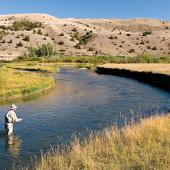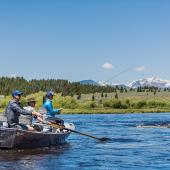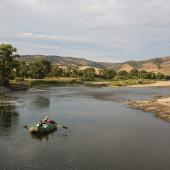The Big Guns
The dirt on streamer fishing for big trout.
Most anglers envision fly fishing as gracefully casting across limpid pools to gently rising trout. While this iconic picture can certainly be fulfilled on the beautiful rivers of southwest Montana, sometimes anglers need something more. Instead of a calm and elegant art, many prefer the pulse-pounding excitement of splashing down flies into deep holes and feeling the rod nearly yanked from their hands by a giant, predatory trout. For those craving this edge-of-your-seat type of angling, there’s nothing better than streamer fishing.
Equipment
Fishing with streamers means beefier equipment. Rods, lines, and leaders need to be heavier and stronger—both for casting large flies (which often have the aerodynamics of a wet tube-sock), and for handling the larger and stronger fish that streamers inevitably catch.
The majority of anglers in southwest Montana do most of their fly fishing with a five-weight rod. However, serious streamer anglers prefer to use six- or seven-weight rods, which have a lot more backbone for casting and for fighting big fish. Fly lines for streamer fishing are typically weight-forward lines with thicker shooting heads that can turn over big flies. Many streamer anglers will actually overload their rods with lines that are a size or two larger than the rods themselves, which helps to generate more power for casting large streamers greater distances.
For those who dream of big trout and wonder just what lurks in the shadows of their favorite rivers, fishing streamers may be the best way to have their questions answered.
Leaders should be in the 12- to 25-pound range, depending on the size of the river and the fish being pursued. Though the larger, more aggressive trout that attack streamers are rarely leader-shy, it’s common to use lighter leaders when fishing streamers in low, clear water. In addition, when using a floating line, it can help to use a sinking leader when fishing deep holes to ensure that your fly is getting down to, and staying at, the desired depth.
Patterns
Streamers come in a vast menagerie of designs, colors, and sizes, each having its own distinct action and fishing method. This wide array of patterns can make streamer fishing intimidating to fishermen who often don’t know which streamers to use at which times. Yet, with a little understanding of flies and trout behavior, anglers can catch big fish on streamers all year long.
In the early season, snowmelt and heavy rains can fill the rivers, leaving them high, muddy, and cold. This is especially true on rivers like the Yellowstone and the Jefferson, which carry a lot of sediment. During runoff, anglers should use larger, gaudier streamer patterns that present a large profile and can be smacked right against the bank or splashed down close to cover. In high water, trout will often hit the fly as soon as it lands or when it’s just starting to sink, so it’s best to only cast and then strip the fly a couple of times before moving on to the next spot.
During mid-summer when water temperatures rise, small, heavy streamers work best. In warm water, trout tend to gather in deeper holes and pools, meaning that anglers need to use patterns that will get down quickly and can be jigged along the bottom. Streamers that imitate sculpins are usually perfect for this sort of thing, especially in rivers like the Yellowstone and the Gallatin which have high populations of these small, bottom-dwelling fish.
In autumn, when rivers are flowing low and the water is clear, anglers tend to have the most success on larger, unweighted patterns. Good flies often have a very realistic swimming action and can be cast great distances—ideal for targeting spread-out fish in shallow water. Swinging, casting, and stripping, or even dead-drifting fly patterns, can draw a lot of strikes—especially when fishing in areas of transition where water depth rapidly changes, or in spots with a lot of structure. Both areas are fantastic ambush points for large trout, especially during the late fall when brown trout are beginning to spawn and other trout species are in search of large meals before freeze-up.
Rationale
Streamer fishing is a niche fishing method, and it isn’t for everybody. Many anglers love to see the rising form of a trout sipping a drifting dry fly and think of streamer fishing as a lot of work for not a lot of results. Yet for those who dream of big trout and wonder just what lurks in the shadows of their favorite rivers, fishing streamers may be the best way to finally have their questions answered.
Kubie Brown is an outdoor guide and writer living in southwest Montana.










